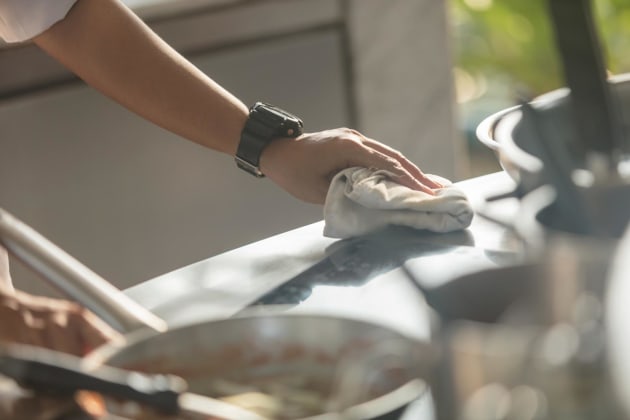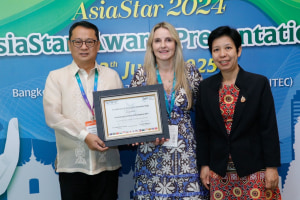FZP, FZS, SSZ, NFZ: A HACCP International certificate will have one of these ‘food zone’ codes to inform the user where, in a food handling operation, they are safe to use - but what does it all mean?
Do you eat off the floor? Of course not! So, you don’t need a food-grade floor, right? Wrong.
If you are a food manufacturer, or operate a food handling facility, then you absolutely need a food-grade floor. But how can a material that doesn’t touch food be ‘food-grade’?
At HACCP International, it is a question we get asked lot. We operate a certification scheme for food-safe equipment, materials and services, including floors and equipment like pest management devices.
Items like floors and pest equipment can be food safe and suitable for use in food handling facilities even though they are never supposed to come into contact with food. Other items, like gloves for example, are designed to touch food directly. They too need to be food safe.
In your food facility, gloves need to be food safe and suitable their intended use. As does the floor and all the other equipment and materials in your facility.
What is important is that each item is suitable for its intended use. We use the concept of food zones to define which products are suitable for what area.
Food zones are areas of a food handling facility, or parts of a food handling device.
The zones that are closest to open or exposed foods are called food zone primary and food zone secondary.
Beyond the primary and secondary food zones, further away from exposed food is the ‘splash and spill zone’. This is the area of a food facility that is close to exposed food but isn’t supposed to be touched by food that will be eaten.
The splash and spill zone of a commercial kitchen includes shelves, walls, floors and racking. This area usually get pretty messy during busy food production times.
Moving further away from the splash and spill zone you will find the non-food zone, which is anywhere in a facility or device that is away from production and exposed food.
Finished goods stores, offices, gardens, loading docks and plant rooms are non-food zones.
Back in the food zone, items need to be suitable for either touching food directly or for coming into contact with items that will touch food.
Direct contact items – we call these food zone primary – are things that are intended to touch food, including gloves, utensils, conveyor belts, tanks, pipes, filters, and food containers.
Food zone secondary items don’t usually touch food directly, but they come into contact with items that do, such as dishwashing detergent, sanitisers for cutting boards, and scour pads for cleaning griddles.
Food zones and certification
A production-room floor doesn’t need to be suitable for eating off, but it does need to have a hygienic, non-absorbing finish and be easy to clean. If it meets our standards and is suitable for use in a production room, we certify it with the splash and spill zone classification.
Food zone classifications are always based on the intended or expected use of the item.
For example, disposable food handling gloves are designed fortouching food, so gloves are always certified as food zone primary. If we determine that a submitted brand of glove is not suitable for handling food we do not certify them. We do not ‘downgrade’ them to a different food zone: what’s the point of having a food handling glove that is not suitable for touching food?
Equipment is evaluated and certified in the same way, according to where it is intended to be used. Equipment that is suitable for use in a commercial kitchen or production area but isn’t intended to be in the food zone is classified as splash and spill zone. Examples include shelving, racking and dispensers for wipes or soap.
Liquid dispensers
Splash and spill zone equipment includes some cleaning liquid dispensers and some equipment that makes or dispenses liquid on demand.
As for the liquids that come out of such equipment, our risk-based evaluation process makes sure that the liquid is food-safe and suitable for its intended use.
HACCP International certifies equipment that dispenses drinking water, and other equipment that dispenses cleaning liquids or sanitisers.
To be certified, the liquid must do what the equipment supplier says it will do. And it must be food-safe for its intended use according to its stated purpose.
Sometimes the certification evaluation process finds a problem. For example, a drinking water dispensing system that claimed to be effective at removing Legionellae bacteria could not be certified by HACCP International because the filters inside the system could not be verified as effective for Legionella control.
Equipment that dispenses liquid for washing food is a growing category. These are machines that make fruit and vegetable wash on site and on demand. Dispensing equipment that is installed or used in kitchens and production areas is certified with the splash and spill zone classification.
Our certification conditions also include information about the suitability of the liquid, if necessary. So if the supplier claims the liquid is suitable for use as a food wash, we ensure that it is food safe and include written confirmation on the certification statement.
To learn more about our Certification Scheme for Equipment, Materials and Services, visit www.haccp-international.com.
This article first appeared in the October edition of Food & Drink Business magazine.






